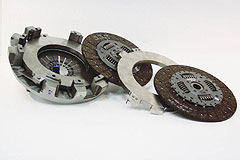Make / Model Search
News - FPV - F6 - TyphoonFPV cures clutch problemFixed: FPV's F6 270 turbo six now offers a more linear power curve. FPV resolves "cataclysmic" clutch failure to get Typhoon and Tornado back on track2 May 2005 A SIMPLE part costing 50 cents was responsible for a costly recall and much publicised halt in production of Ford Performance Vehicle’s new halo performance vehicles, the Typhoon sedan and Tornado ute. FPV admitted last week that a small, star-shaped clip, one of three used in the clutch assembly, failed because of vibration and the greater torque loads of the F6 270kW straight-six turbo engine. The clips were designed to hold an intermediate clutch pressure plate in the correct position. When they failed the intermediate pressure plate was forced on to the driveline friction plate, creating clutch drag. FPV managing director, David Flint, admitted that the problem was a costly blow to FPV’s image but said much had been done to rectify it and also keep owners and buyers informed. "We have gone for 14 years without problems and then we have a cataclysmic problem," he said. But Mr Flint said the fix meant that FPV, and Ford, had "a process that’s wider and stronger and useful to all". It took three weeks to find out what caused the actual failure but FPV also had to develop a benchmark customer treatment process "so they were not left in denial", Mr Flint said. He said he was buoyed by the positive reaction from FPV customers. In all 128 Typhoons were affected with FPV and Ford offering owners the option of a replacement vehicle. Just 33 owners did so. FPV also had 25 orders on the books and only four buyers opted out of their Typhoons to buy other FPV cars. "The majority were happy to wait for a fix," FPV’s marketing and sales manager, Roger Gray said. In all 28 clutches failed but Ford's, and FPV's, early intervention have prevented a public relations disaster. The revised hand-built six-speed clutch will be shipped to dealers this week and it is expected to take a month for every car to be retro-fitted.  It appears the natural vibrations - described as unique harmonics - and greater loads of the F6 270kW straight-six turbo engine may have accelerated the clip's failure, despite the extensive validation and durability trials conducted on the car and its mechanicals. It appears the natural vibrations - described as unique harmonics - and greater loads of the F6 270kW straight-six turbo engine may have accelerated the clip's failure, despite the extensive validation and durability trials conducted on the car and its mechanicals.A number of similar clips are used in V8 and V12 engines in the Ford family, including the Aston Martin DB9 and the Ford GT but there have been no problems with other clutch packs in these engines. But the six-cylinder turbo was the only application in the world that uses the clips. Ford president, Tom Gorman, would not put a cost figure on the whole episode, saying that the fix had "no material impact". However, the halt in production, new durability and validation process and fast-tracking an engineering and manufacturing fix is believed to have cost millions. "When the problem became evident, we took some major decisions immediately - we stopped selling cars," Mr Gorman said. Ford and FPV have now instituted tougher validation and durability measures on FPV products to make sure the niche high-performance machines are up to the task of delivering performance without problems. The Typhoon has a twin-plate clutch and the 50c clips have been eliminated. FPV admits now that a single-plate design may not have had the increased torque characteristics to cope with the F6's massive 550Nm of torque. AP Racing in the UK, which helped develop the previous clutch, was involved in redesigning the replacement, which now has a torque rating of more than 700Nm. FPV engineer Alastair Bacon said the re-engineering program involved 1100 man hours of analysis using high-tech computers, virtual modelling and aeronautical visualising equipment to look at the clutch. "In essence we deleted parts that were failing," he said. The work also involved reducing friction in other areas of the pressure plate to essentially make the clutch operation a lot simpler, he said. Six variations of the specification were developed and an F6 Typhoon was air-freighted to the UK to ProDrive’s Warwick test facility while 18 other cars covered almost 100,000km in high-speed durability testing. Three cars were driven 24-hours a day for six weeks to simulate a 10-year, 250,000km lifecycle of the car and components. Mr Bacon said two senior Prodrive Asia-Pacific staff spent two months at AP Racing working on the fix. The overall program was massive and involved not only Ford Australia but Ford USA, Prodrive UK and Aston Martin. Apart from fixing the problem one of the other benefits of the new clutch has been that FPV has been able to recalibrate the F6's engine idle characteristics and improve the engine's high temperature ambient performance, increasing the point at which the engine restricts performance with revised boost control mapping. Mr Bacon said the F6 now provides a more linear power curve at high engine speeds without any increase in peak power or torque. Lessons learned from the F6 will now go into other FPV products. Mr Flint said when the clutch problem arose three months ago FPV had two tasks to complete "to get to the bottom and find the physical problems" but also to beef up FPV testing protocols in the future. He is confident that both requirements have been addressed. |
Click to shareFPV articlesResearch FPV Motor industry news |









Facebook Twitter Instagram